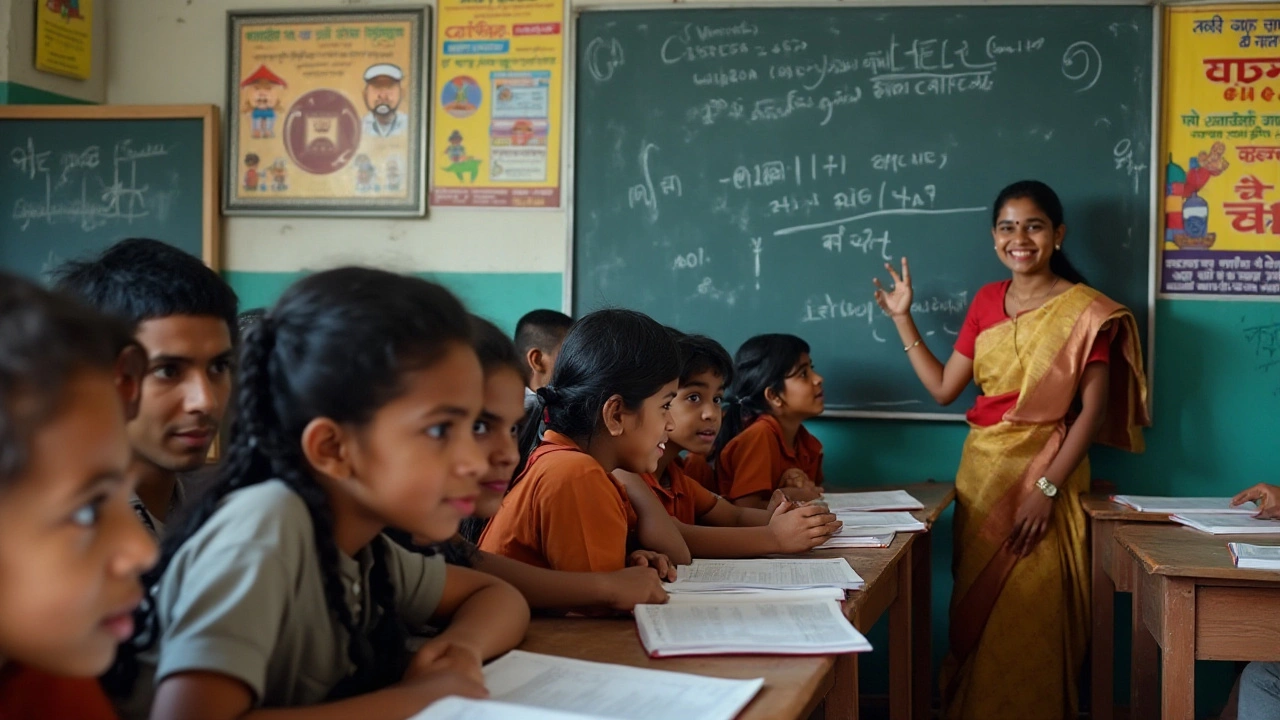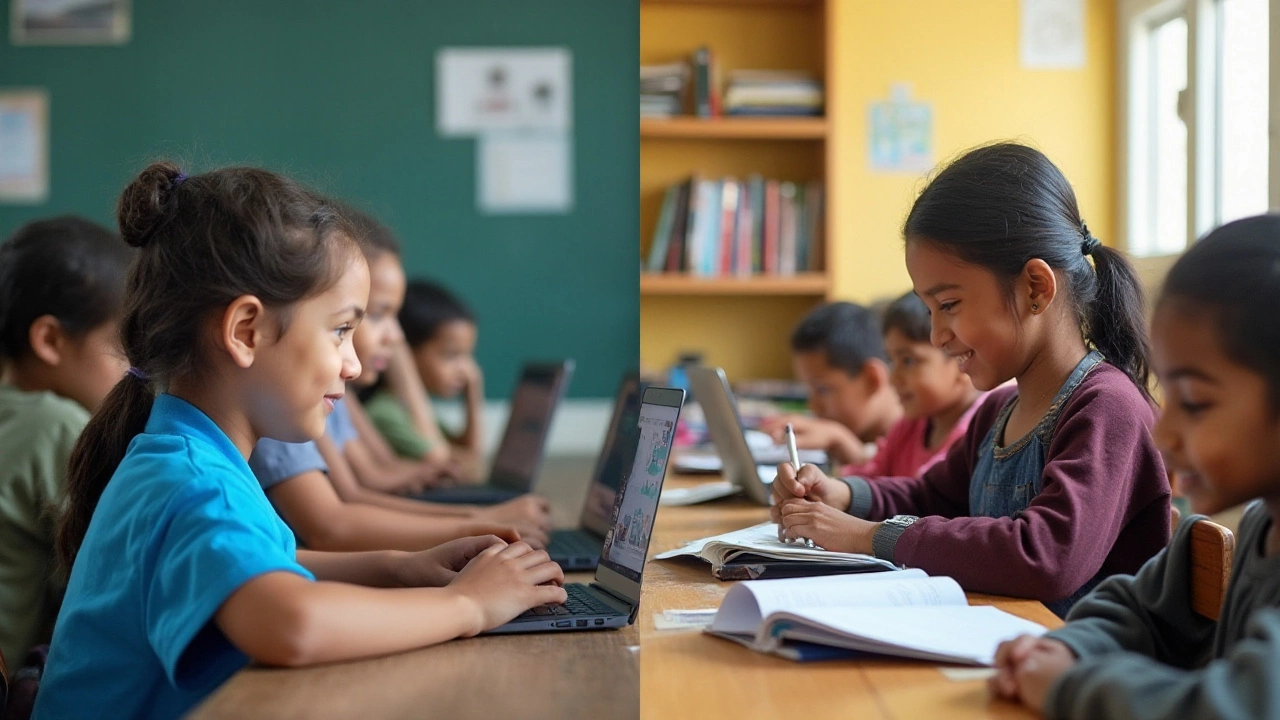Comparing Educational Approaches: USA vs. India under the CBSE Lens
 Jan, 20 2025
Jan, 20 2025
The landscape of education across the globe is as varied as it is intricate. For many parents, students, and educators, comparing systems like those in the United States and India can offer enlightening insights. Is one approach inherently superior to others? Well, it depends largely on what parameters you consider important.
In the context of the Central Board of Secondary Education (CBSE), this article delves into a comparative study of education in the USA and India. Each system comes with its own set of philosophies, goals, and methodologies. Whether it's the balanced emphasis on holistic development in American schools or the rigorous academic focus found in Indian classrooms, both offer unique benefits and challenges that cater to different sets of aspirations.
Understanding these differences is not just academically stimulating; it also offers practical knowledge for anyone making decisions about education. Let's take a closer look at key aspects that define these education systems under the lens of the CBSE curriculum.
- Educational Framework and Structure
- Curriculum and Teaching Styles
- Student Experience and Outcomes
- Challenges and Opportunities
Educational Framework and Structure
When diving into the educational narratives of both the USA and India, one of the striking elements lies within their structural differences. The United States, with its decentralized model, offers a broad spectrum of choices. Each of its states holds autonomy over the educational guidelines, though they work within certain federal frameworks. This results in a diverse range of schools like public, private, and charter institutions that contribute to varied educational experiences. On the contrary, India's system, especially when looking at the Central Board of Secondary Education (CBSE), is relatively centralized and standardized. The CBSE is known for maintaining uniformity in curricula across its affiliated schools, emphasizing a core structure that aims to deliver a consistent learning experience nationwide.
A prominent feature of the American system is its extensive array of electives and extracurricular activities that engage students beyond basic academics. They prioritize a more holistic education model, encouraging students to develop arts, sports, and life skills alongside traditional subjects. This model attempts to foster critical thinking and creativity, catering to diverse educational needs. In contrast, the CBSE-centric system in India largely emphasizes a strong academic foundation, with rigorous attention to subjects such as mathematics, science, and languages. While co-curricular activities exist, they often hold secondary importance compared to core academics.
Discussing governance, American schools enjoy substantial local control over educational affairs. This flexibility allows schools to innovate and adapt their teaching methods to best suit their student populations. According to the National Center for Education Statistics, nearly 50.7 million students were enrolled in public elementary and secondary schools in the fall of 2022, indicating the broad reach of this system. On the other hand, CBSE's central body organizes periodic updates to its curriculum, ensuring that educational standards are uniformly maintained across its reach of nearly 21,000 institutions in India and abroad. Such centralization aims to bring consistency in the educational quality.
The course progression also highlights differences, with the USA system adopting a more fluid approach through its K-12 framework, allowing for adjustments based on student interests and strengths. The curriculum is designed to be exploratory, offering career-technical and vocational education opportunities. The Indian education system, via CBSE, follows a more linear path, generally aiming to build an incremental knowledge base leading up to board examinations in the 10th and 12th grades. These exams are crucial, often acting as determinants for higher education opportunities. This distinct focus on exams and ranks often shapes student experience and parental perceptions.
Interestingly, both countries have started to learn from each other. There is a growing trend to incorporate STEM-focused curricula in US schools, much like the emphasis in Indian education. Simultaneously, Indian schools are beginning to adopt more extracurricular initiatives to promote a well-rounded mindset. In a detailed review by Brookings, it was pointed out that, "as global economies evolve, education systems need to pivot towards holistic criteria—balancing traditional academics with skill-based learning."
Cultural exchanges and global partnerships tend to influence these evolving educational landscapes.

Curriculum and Teaching Styles
Understanding the curriculum and teaching styles in the USA and India, especially through the lens of the CBSE syllabus, illuminates numerous interesting differences. In the United States, educational institutions often have a liberal approach, offering students the flexibility to choose from a variety of subjects, fostering independence, and often emphasizing a hands-on, experiential mode of learning. This contrasts with India’s CBSE framework, which is known for its more structured and standardized approach. The CBSE curriculum focuses heavily on core academic subjects such as mathematics, science, and language, aiming for an in-depth understanding grounded in theoretical knowledge.
In American schools, there is a significant focus on developing critical thinking and problem-solving skills. Teaching styles here incorporate a mix of collaborative projects, group discussions, and research-based assignments. This encourages students to question, innovate, and apply what they learn in real-world contexts. On the other hand, Indian CBSE schools typically lay greater emphasis on rote memorization and theoretical analysis.
"Education is not the learning of facts, but the training of the mind to think," Albert Einstein once noted. This perspective finds itself aligned more closely with the American pedagogical approach, which prioritizes the 'how' over the 'what' of education.
The grading systems also reflect these pedagogical philosophies. In the USA, evaluations tend to be more holistic, assessing students' performance through continuous assessments like assignments, quizzes, and participation. Meanwhile, the CBSE relies on summative assessments, majorly through finals and board examinations, to gauge student proficiency. The disparities are also evident in class size and teacher-student interaction. American classrooms often nurture a low student-to-teacher ratio, enabling personalized attention and mentoring. In contrast, Indian classrooms may sometimes have a higher student count, which impacts the level of individual focus a teacher can provide.
Despite these contrasts, both systems offer unique opportunities and face similar challenges such as adapting to technology or addressing diverse student needs. A recent survey revealed that American students, on average, experience more interdisciplinary studies, whereas Indian students advancing under the CBSE purview emphasize a more streamlined career path directly linked to their educational pursuits. While the India education strategy leverages robust exam-oriented teaching methods, the USA schools incorporate broader, curriculum-focused education that encourages diverse learning styles. Schools across both nations continuously evolve and innovate, integrating digital tools and revamping curricula, aiming to enhance student engagement and success.
| Aspect | USA Education | CBSE (India Education) |
|---|---|---|
| Teaching Style | Experiential, flexible | Theoretical, structured |
| Assessment | Continuous, diverse | Summative, exam-focused |
| Class Size | Generally smaller | Varies, often larger |

Student Experience and Outcomes
The experience students gather through their educational journeys is more than just acquiring knowledge—it shapes their outlook and future endeavors. In India, particularly under the CBSE syllabus, the educational experience is often marked by a high degree of structure and discipline. This system is designed to ensure a robust foundation in core subjects such as science, mathematics, and languages. The emphasis is greatly on rote memorization, a method that frequently proves effective in acing exams but often at the cost of critical thinking and creative problem-solving skills. In comparison, the education system in the United States endeavors to create a more holistic learning environment. Schools often aim to balance academic challenges with extracurricular activities, encouraging students to explore various interests and develop diverse skill sets.
The differences in student outcomes from these educational approaches reflect these pedagogical styles. Indian students, under the CBSE system, often excel in competitive examinations, both nationally and internationally. Their ability to perform in rigorous test environments is notably due to the CBSE's strong focus on comprehensive curriculum coverage. However, engagement in original thought and innovation can sometimes be underscored, a point highlighted by global education trends. The American system, albeit diverse and occasionally inconsistent, prides itself on producing students who are daring and entrepreneurial. According to a report published by the National Center for Education Statistics,
"U.S. education tends to foster a sense of inquiry and exploration that equips students with the skills essential for navigating our rapidly changing world."
But what does this mean for real-world success? A key outcome difference is seen in higher education preferences. Indian students, with their persistent focus on academics, are well-prepared for STEM-related fields. Many internationally acclaimed professionals in technology and medicine hail from India, and this is a testament to the analytical rigor they have imbibed during their schooling years. In contrast, American graduates are often seen pursuing varied fields, including arts, sports, and innovative tech startups. Their education system's nurturing of diverse interests aids in this multidisciplinary approach.
As we delve deeper, it's important to acknowledge unique challenges each system faces that affect outcomes. In India, the vast population and limited resources can create a competitive yet tough-to-maneuver academic environment, often putting significant pressure on students. The USA, on the other hand, while rich in resources, sometimes encounters disparities in educational quality across different regions which can impact student experiences negatively. Here, questions of equity and access to quality education arise, prompting ongoing reforms.
Ultimately, the student experience and outcomes are shaped by a confluence of teaching styles, cultural values, and social-economic conditions. For both nations, it's the collaborative efforts of educators, policymakers, and communities that can help in addressing limitations and enhancing strengths. As these systems evolve, they offer valuable lessons on cultivating adaptable, resilient, and forward-thinking future citizens. Whether under the plethora of opportunities in the USA or within the structured rigors of India's education system, students are being prepared to face a world far more interconnected and complex than before.

Challenges and Opportunities
An interesting factor often overlooked when comparing the education system of the USA and India is the wide array of challenges and opportunities they both present. In the USA, one of the significant challenges is the prevailing inequality in school funding. Given that public schools are primarily financed through local property taxes, schools in wealthier communities tend to have more resources. This often results in a significant disparity in the quality of education offered, with students in affluent areas having access to better facilities and experienced educators. Such inequality poses a considerable challenge to achieving an equitable education system across the country. But with every challenge arises an opportunity; the USA's diverse and flexible curriculum structure offers students the chance to pursue varied interests and talents, preparing them well for a variety of post-secondary pathways.
In India, the challenge often revolves around the sheer volume of students and the pressure this places on resources. With a population exceeding 1.4 billion, and a significant portion being school-age children, the system is frequently stretched thin. Teachers may find themselves managing classrooms with 50 or more students, making individualized attention a rare luxury. However, this challenge fosters innovation and resilience among learners and educators alike. The emphasis on self-discipline and mastery of hard subjects, characteristic of the CBSE syllabus, often leads to excellent problem-solving skills and adaptability among Indian students. "Education is not the learning of facts, but the training of the mind to think," noted Albert Einstein, echoing the CBSE ethos that encourages analytical skills beyond rote memorization.
Another opportunity within the Indian education system lies in its increasing integration of technology. Initiatives are underway to include digital tools in classrooms, addressing both access and quality issues. The Digital India campaign, for example, aims to enhance digital infrastructure, which offers the dual benefit of bridging educational gaps, especially in rural areas, and preparing students for a rapidly digitalizing world. Meanwhile, the USA system's focus on inclusive education ensures that students with varied learning needs receive tailored support, thanks to legislation like the Individuals with Disabilities Education Act (IDEA), which encourages educational institutions to cultivate inclusive environments. Each country faces distinct challenges, yet in addressing these head-on, they find new routes to improve educational accessibility and effectiveness.